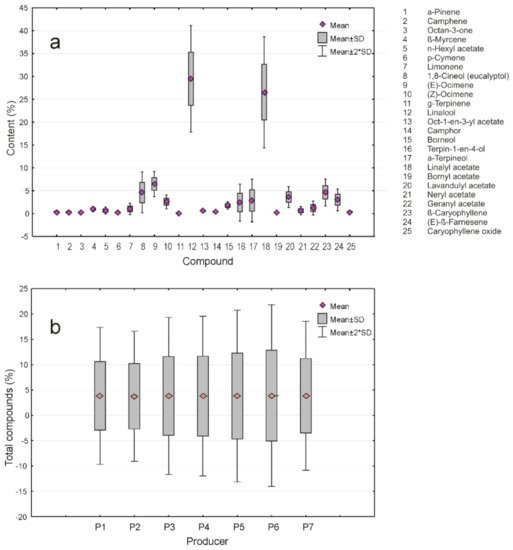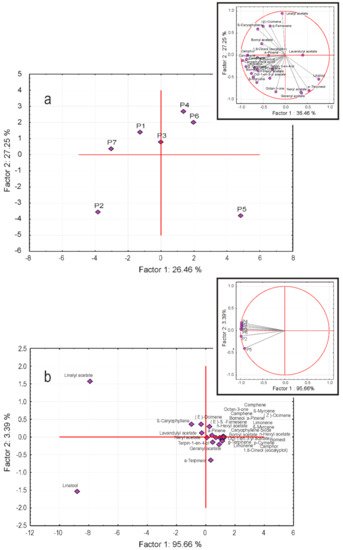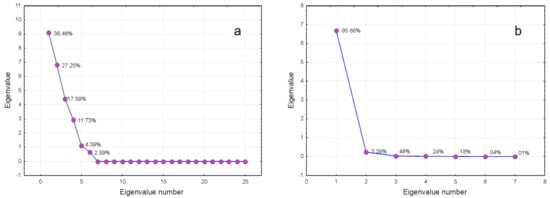The producers of essential oils from the Republic of Moldova care about the quality of their products and at the same time, try to capitalize on the waste from processing. The purpose of the present study was to analyze the chemical composition of lavender (Lavanda angustifolia L.) essential oil and some by-products derived from its production (residual water, residual herbs), as well as to assess their “in vitro” antimicrobial activity. The gas chromatography-mass spectrometry analysis of essential oils produced by seven industrial manufacturers led to the identification of 41 constituents that meant 96.80–99.79% of the total. The main constituents are monoterpenes (84.08–92.55%), followed by sesquiterpenes (3.30–13.45%), and some aliphatic compounds (1.42–3.90%). The high-performance liquid chromatography analysis allowed the quantification of known triterpenes, ursolic, and oleanolic acids, in freshly dried lavender plants and in the residual by-products after hydrodistillation of the essential oil. The lavender essential oil showed good antibacterial activity against Bacillus subtilis, Pseudomonas fluorescens, Xanthomonas campestris, Erwinia carotovora at 300 μg/mL concentration, and Erwinia amylovora, Candida utilis at 150 μg/mL concentration, respectively.
1. Introduction
Lavandula angustifolia Mill. (syn.
Lavandula vera DC, syn.
Lavandula officinalis Chaix ex Vill., syn.
Lavandula spica L.) is a perennial evergreen shrub of the family
Lamiaceae, native to the Mediterranean region. Nowadays, this species is naturalized almost all over Europe, North Africa, United States, and Australia
[1].
L.angustifolia (Lavander) is one of the most valuable medicinal and aromatic plants traditionally used to treat pain, parasitic infections, burns, insect bites, cramps, and muscle spasms
[2]. In addition to its application in herbal treatment, lavender is also cultivated for the essential oils used in aromatherapy and the cosmetic, food, and flavour industries
[3][4][5][3,4,5].
This is possible due to the presence of a set of biologically active substances, especially in essential oil, which possesses a multidirectional therapeutic activity being used in the treatment of gastrointestinal, cardiovascular, respiratory, and urinary infections
[6]. Scientific studies reported anti-inflammatory
[7], antioxidant
[8][9][8,9], sedative
[10], cytotoxic
[11][12][11,12], analgesic
[7], antimicrobial
[6][13][14][6,13,14], and anticonvulsive
[15] properties of
L. angustifolia essential oil. Literature data reveal a huge variation in terms of
L. angustifolia essential oil content, with values ranging between 0.5 and 6.25% in the case of essential oil obtained from fresh and dry inflorescences
[16]. The main constituents of
L. angustifolia essential oil are linalool, linalyl acetate, 1,8-cineole, borneol, camphor, lavandulyl acetate,
β-caryophyllene,
β-ocimene,
α-fenchone, terpinen-4-ol, caryophyllene oxide, limonene, pinenes, geranyl acetate,
β-farnesene, santalene, lavandulol, camphene, geraniol, and
α-terpineol
[8][11][13][14][17][18][19][20][21][22][23][24][25][26][8,11,13,14,17,18,19,20,21,22,23,24,25,26]. The content of oxygenated monoterpenes prevails in
L. angustifolia essential oil and varies between 36.33 and 92.90%
[16].
The therapeutic effects of
L. angustifolia are also determined by secondary metabolites such as oleanolic and ursolic acids, together with other pentacyclic triterpenes.
[27][28][27,28]. It has been proven experimentally that both compounds in pure forms, as well as their synthetic derivatives, show multiple biological activities
[29][30][31][32][33][34][35][36][37][38][29,30,31,32,33,34,35,36,37,38].
Some by-products, e.g., pomace or solid residues, that resulted after hydrodistillation of essential oil-producing plants could be considered as a source of biologically active compounds such as ursolic and oleanolic acids. In addition, residual distillation waters have various applications due to their aromatic and antimicrobial properties
[39][40][41][42][43][39,40,41,42,43].
Antibiotic resistance is becoming one of the main problems of modern medicine since it substantially reduces the effectiveness of antibacterial treatments and is linked to increased patient mortality. As a result, known antibacterial preparations cease to be safe and effective against infections caused by resistant bacteria, leading to increasingly serious cases, including hospital-acquired complications. This requires the discovery of new classes of antibiotics or optimization and a combination of known compounds. However, microorganisms will likely evolve resistance in time and further research and development may be hard to sustain by the pharmaceutical companies. For this reason, studies are being conducted to identify effective remedies against multidrug-resistant strains. Preference is given to natural products among which are the essential oils
[44], including lavender
[45], or their combination with antibiotics
[46]. Still, information about the antimicrobial activity of residual water and ethanolic extracts is very scanty and is mainly related to Lavander hydrosol, which is produced synthetically
[47].
2. Discussion
2.1. Chemical Composition of Lavender Essential Oils
The essential oil manufactured by producer P1, destined for export, had the following physico-chemical properties: Density (20 °C)—0.8920 g/mL; refractive index (n
20D)—1.4660, and optical rotation (
α20D)— −7.0°.
The most multitudinous group of terpenic compounds are monoterpenes, which include C
10-hidrocarbones (8.72–15.32%) and their oxygenated derivatives (69.0–83.83%). The main constituents of this group which determine the quality and genuineness of lavender essential oil, according to the International Standard
[48], are (%): 1,8-cineol (eucalyptol) (<1.0), (
E)-ocimene (4.0–10.0), (
Z)-ocimene (1.5–6.0), linalool (25.0–38.0), camphor (<0.5), terpin-1-en-4-ol (2.0–6.0),
α-terpineol (<1.0), linalyl acetate (25.0–45.0), and lavandulyl acetate (>2.0) (
Table 1 and
Table 2).
Table 1. Phytochemical (terpenic and aliphatic compounds) composition of lavender essential oil of Moldovan origin.
| No. |
| 96.80 |
| 97.62 |
| 99.11 |
| 98.51 |



